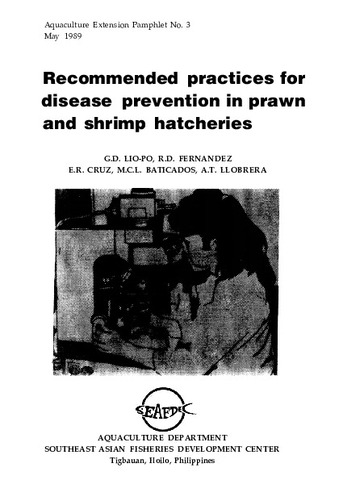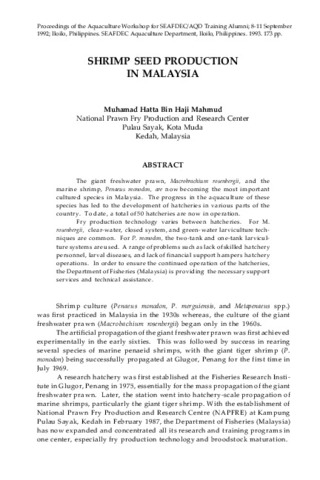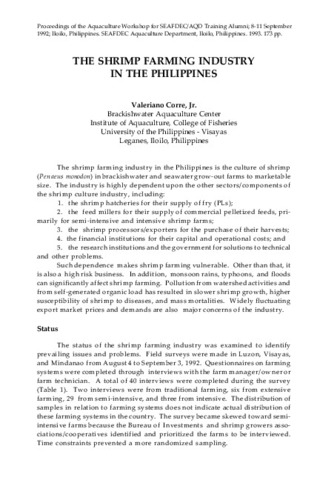Recommended practices for disease prevention in prawn and shrimp hatcheries
- Global styles
- MLA
- Vancouver
- Elsevier - Harvard
- APA
- Help
Share
นามธรรม
Disease in prawn is any abnormal condition which may affect adversely the appearance, growth, and function of the animal. It may or may not result in mortalities. Disease outbreaks occur commonly in different culture systems such as hatcheries and grow-out ponds.
Disease develops through the interaction of the prawn (the host), the causal agent (the pathogen), and the environment. In the presence of a susceptible host, a pathogen and predisposing environmental conditions (poor water quality, inadequate food, frequent handling, overstocking), disease is very likely to occur. Improved environmental conditions, healthy prawns and absence of disease agents would therefore lessen the chance of a disease outbreak.
The causal agents may be pathogenic organisms (viruses, bacteria, fungi, protozoa, helminths, microcrustaceans) or nonpathogenic adverse environmental conditions (extreme temperatures, low oxygen levels, chemical poisons). Living disease agents cause infectious disease which generally result in gradual mortalities. Non-living disease agents cause non-infectious diseases that result in sudden mass mortalities.
The environment determines the balance between the prawn as host and the disease agent. Microorganisms are always present in the water and some of them cause disease only when the prawn has been weakened through exposure to stressful environmental conditions.
Hatchery personnel should realize that they themselves could transmit disease through their contaminated hands, clothing, and footwear. Equipment such as water pumps, blowers, pipes, and materials such as scoop nets, water hoses, pails, glasswares are also possible carriers of disease agents. Spawners, live natural food like diatoms, rotifers and brine shrimp, and artificial diets could also be vehicles of disease transmission.
The prawn culturist, thus, must be able to manage the environment and make it favorable for the prawn. Hatchery management should, therefore, include operation procedures that will reduce the possibility of disease development during larval rearing. This manual recommends practices for disease prevention to prawn hatchery operators and technicians.
การอ้างอิง
Lio-Po, G. D., Fernandez, R. D., Cruz, E. R., Baticados, M. C. L., & Llobrera, A. T. (1989). Recommended practices for disease prevention in prawn and shrimp hatcheries. Tigbauan, Iloilo, Philippines: Aquaculture Department, Southeast Asian Fisheries Development Center.
Type
Bookชุด
Aquaculture extension pamphlet / SEAFDEC Aquaculture Department; No. 3คอลเลกชัน
Related items
Showing items related by title, author, creator and subject.
-
Research on crustaceans
Parado-Estepa, Fe D. (Aquaculture Department, Southeast Asian Fisheries Development Center, 1995)Crustacean research at the SEAFDEC Aquaculture Department during the last three years focused mostly on the tiger shrimp Penaeus monodon. Studies were done along six problem areas: (1) developing spawning techniques for ... -
Shrimp seed production in Malaysia
Muhamad Hatta Bin Haji Mahmud (Aquaculture Department, Southeast Asian Fisheries Development Center, 1993)The giant freshwater prawn, Macrobrachium rosenbergii, and the marine shrimp, Penaeus monodon, are now becoming the most important cultured species in Malaysia. The progress in the aquaculture of these species has led to ... -
The shrimp farming industry in the Philippines
Corre, Valeriano, Jr. (Aquaculture Department, Southeast Asian Fisheries Development Center, 1993)The shrimp farming industry in the Philippines is the culture of shrimp (Penaeus monodon) in brackishwater and seawater grow-out farms to marketable size. The industry is highly dependent upon the other sectors/components ...






